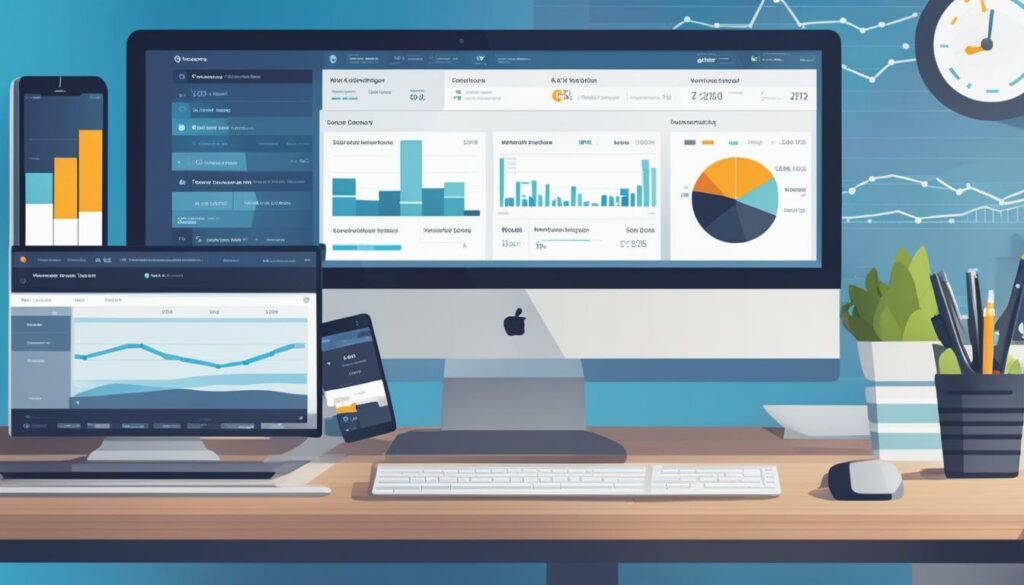WordPress is an incredibly versatile content management system (CMS) that is widely used for creating and managing websites. In fact, it’s the go-to platform for many e-commerce businesses. If you’re looking to set up an online store with WordPress, you’ve come to the right place. In this article, we’ll guide you through the essential steps to master the basics of e-commerce solutions for WordPress, ensuring your website’s performance, security, and optimization.
One of the key aspects of running a successful e-commerce store is monitoring your WordPress site closely. This includes keeping an eye on key metrics such as website performance, uptime tracking, real-time analytics, security, and more. By actively monitoring your site, you can identify and address any issues promptly, ensuring a seamless shopping experience for your customers.
Key Takeaways:
- WordPress Monitoring plays a crucial role in e-commerce success.
- Website performance monitoring ensures a seamless shopping experience.
- Real-time website analytics provide valuable insights for optimization.
- WordPress security monitoring keeps your site safe from potential threats.
- Website speed optimization enhances user experience and boosts conversions.
Installing WooCommerce
The first step in setting up your e-commerce website is installing the WooCommerce plugin on your WordPress site. This can be easily done through the WordPress dashboard by navigating to “Plugins” and clicking on “Add New”.
- Access your WordPress dashboard.
- Click on “Plugins” in the sidebar menu.
- Select “Add New” from the dropdown menu.
- In the search bar, enter “WooCommerce”.
- Locate the WooCommerce plugin and click on “Install Now”.
- After the installation is complete, click on “Activate” to enable the plugin.
Once WooCommerce is activated, you can begin setting up your e-commerce store using the setup wizard.
By installing WooCommerce, you gain access to a powerful toolkit that transforms your WordPress website into a feature-rich online store. It allows you to manage products, inventory, payments, and more, all from your WordPress dashboard.
| Benefits of Installing WooCommerce |
|---|
| Easy integration with WordPress |
| Extensive customization options |
| Flexible product management |
| Secure payment gateways |
| Wide range of plugins and extensions |
| Seamless order management |
Configuring Basic Settings
Once you have activated WooCommerce, it’s time to configure the basic settings to ensure that your online store is set up according to your business requirements. By customizing these settings, such as store location, currency, and product types, you can provide a seamless shopping experience for your customers that aligns with your specific needs and target audience.
Start by following the WooCommerce setup wizard, a helpful tool that will guide you through the process step by step. This wizard streamlines the initial setup and allows you to customize your store without any technical expertise.
First, specify your store location. This information will help WooCommerce calculate accurate tax rates and shipping options. Enter the location details, including the country, state, and city, to ensure that your customers have the correct information when placing orders.
Next, choose the currency that you want to display on your online store. Selecting the appropriate currency is essential for providing a seamless shopping experience for your international customers. Take into consideration the primary markets you cater to and select the currency that is most convenient for your customers.
Moreover, configuring the product types is crucial for organizing your inventory effectively. WooCommerce provides various product types, such as simple, grouped, variable, and external products. Each type serves different purposes and accommodates different business needs. Select the product types that best suit your offerings to ensure proper categorization and streamlined management of your products.
Remember to tailor these settings to your specific business requirements. Understanding your target audience and knowing their preferences will help you make informed decisions when configuring the basic settings of your WooCommerce store.
With these essential configurations, you’re one step closer to creating an exceptional online shopping experience for your customers. Next, we’ll explore how to add products to your store to showcase your offerings and increase sales.
Adding Products
After configuring the basic settings of your online store, it’s time to start adding products to your WooCommerce product catalog. Creating comprehensive and enticing product listings is crucial for attracting and engaging potential customers. Follow these key steps to ensure your products stand out:
-
Create Eye-Catching Product Listings: Craft visually appealing and descriptive listings that showcase your products. Include high-quality images that accurately represent the item and provide multiple angles if necessary. Ensure that the images are clear and optimized for fast loading.
-
Write Detailed Descriptions: Provide compelling and informative descriptions that highlight the features, benefits, and unique selling points of your products. Use persuasive language to captivate your audience and emphasize how your products can meet their needs.
-
Set Accurate Prices: Determine competitive and profitable prices for your products. Consider factors such as manufacturing costs, market demand, and competitor pricing. Keep your prices up to date to maintain transparency and avoid pricing discrepancies.
-
Manage Inventory Details: Keep track of your product inventory to avoid overselling or running out of stock. WooCommerce provides inventory management features that allow you to track stock levels, set low stock notifications, and manage backorders efficiently.
Using WooCommerce’s user-friendly interface, you can easily manage your product catalog, make updates, and organize products into categories for better navigation and user experience. Remember to regularly review and optimize your product listings to ensure they stay relevant and appealing to your target audience.
Case Study: Increasing Sales with Engaging Product Descriptions
“When we revamped our product listings with more detailed and persuasive descriptions, we saw a significant increase in sales. Customers were able to visualize the benefits of our products, which resulted in higher conversion rates. Don’t underestimate the power of well-crafted product descriptions!”
Key Elements for Effective Product Listings
| Element | Description |
|---|---|
| High-Quality Images | Clear, visually appealing images that accurately represent the product. |
| Detailed Descriptions | Compelling and informative descriptions that highlight product features and benefits. |
| Accurate Prices | Competitive and transparent pricing to attract and retain customers. |
| Inventory Management | Efficient tracking and management of product stock levels to avoid overselling or stockouts. |
Selecting Payment Gateways
When it comes to running an online store, one of the most crucial aspects is ensuring secure transactions for your customers. To achieve this, you’ll need to choose the right payment gateways that provide a seamless and secure payment process. WooCommerce, the popular WordPress plugin for e-commerce, offers a wide range of payment options to cater to your customers’ needs and preferences, including credit cards and PayPal.
By selecting payment gateways that support secure transactions, you can give your customers confidence in their purchases and safeguard their sensitive information. Whether they prefer to pay with their credit cards or use services like PayPal, WooCommerce has got you covered.
Secure Transactions with Credit Cards
Accepting credit card payments is crucial for any online business. It provides convenience to customers and allows for quick and secure transactions. With WooCommerce, you can integrate popular credit card processors and payment gateways like Stripe, Authorize.net, and Square into your online store. These payment gateways offer robust security features to ensure that credit card transactions are encrypted and protected from potential threats.
Seamless Payments with PayPal
Another widely used payment method is PayPal, a trusted and secure online payment platform. Many customers prefer PayPal because it offers an extra layer of security by keeping their financial details confidential. WooCommerce seamlessly integrates with PayPal, allowing customers to make payments using their PayPal accounts, credit cards, or even their bank accounts.
The integration between WooCommerce and PayPal ensures a smooth checkout experience for your customers, increasing the likelihood of completed purchases and customer satisfaction.
Offering Multiple Payment Methods
While credit cards and PayPal are popular payment options, it’s important to consider your target audience’s preferences and the payment methods they are most comfortable using. Offering multiple payment methods can cater to a wider range of customers and increase conversion rates on your online store.
WooCommerce supports various payment methods beyond credit cards and PayPal, including digital wallets like Apple Pay and Google Pay, as well as alternative payment providers such as Amazon Pay or Klarna. By diversifying your payment options, you can accommodate different customer preferences and ensure a seamless payment experience for everyone.
| Payment Gateway | Supported Payment Methods | Features |
|---|---|---|
| Stripe | Credit cards, digital wallets | Robust security, customizable payment options |
| PayPal | PayPal accounts, credit cards, bank accounts | Trusted and secure payment platform |
| Apple Pay | Apple devices-linked payment options | Convenient and secure payments for Apple users |
| Google Pay | Google-linked payment options | Convenient and secure payments for Google users |
| Amazon Pay | Amazon-linked payment options | Seamless payments for Amazon customers |
| Klarna | Buy now, pay later options | Flexible financing options for customers |
Table: Payment gateways and supported payment methods
By carefully selecting and integrating the right payment gateways into your WooCommerce store, you can ensure that your customers have a secure and convenient payment experience. Whether they choose to pay with credit cards, PayPal, or other trusted payment methods, your online store will be equipped to handle their transactions seamlessly.

Setting Up Shipping Options
When it comes to running an e-commerce store, setting up shipping options is a crucial step in providing a seamless shopping experience for your customers. With WooCommerce, you have the flexibility to configure shipping methods, rates, and options that align with your business model.
WooCommerce offers various shipping methods to choose from, allowing you to cater to your customers’ needs and preferences. Whether you want to offer flat rates, free shipping, or more complex shipping options based on location, weight, or dimensions, WooCommerce can accommodate your requirements.
By customizing the shipping configuration, you can set specific rates for different products or create shipping rules based on order value. This flexibility ensures that your shipping prices reflect your business needs while providing fair and transparent rates for your customers.
Flat Rates
If you prefer to keep shipping rates consistent, flat rates are a popular option. You can set a fixed shipping price for each order, regardless of the product or its destination. This simplifies the checkout process and makes it easy for customers to calculate the total cost.
Free Shipping
Offering free shipping can incentivize customers to make purchases by eliminating an additional cost. With WooCommerce, you can set a minimum order value for free shipping to encourage higher average order values and increase customer satisfaction.
Complex Shipping Options
For businesses with unique shipping requirements, WooCommerce allows you to configure complex shipping options. You can set shipping rates based on location, weight, or dimensions, ensuring accurate and fair pricing for different scenarios. This level of customization caters to a wide range of business models and product types.
To configure the shipping options in WooCommerce, navigate to the settings section and follow the intuitive setup process. You’ll have the opportunity to define your shipping methods, rates, and additional rules according to your specific needs.
Ensure that you regularly review and update your shipping options to stay aligned with changing business needs and shipping trends. By continuously optimizing your shipping configuration, you can provide a positive customer experience while effectively managing your shipping costs.

Customizing your shipping options is a powerful way to differentiate your e-commerce store and provide a competitive advantage. By setting up shipping methods, rates, and options that align with your business model, you can streamline the ordering process, increase customer satisfaction, and ultimately boost your sales.
Customizing the Design
Make your online store visually appealing and user-friendly by selecting an appropriate theme. WordPress offers a wide range of themes that can be customized to match your brand identity. Adjusting the colors, fonts, and layouts will allow you to create a unique design that reflects your business’s personality.
Creating a visually appealing online store is crucial to capturing the attention of potential customers. When users visit your website, they should be immediately drawn to its visual appeal. A clean, modern design with a user-friendly interface ensures that visitors can easily navigate your store and find what they’re looking for.
Start by selecting a theme that aligns with your brand identity and the products you offer. WordPress provides a vast collection of themes, each with its own style and customization options. Carefully consider the theme’s layout, color scheme, and overall aesthetics to make sure it complements your brand image.
Appropriate Theme Selection
When choosing a theme, keep in mind the nature of your e-commerce business. If you sell luxury goods, for example, a sleek and elegant theme with a minimalist design may be more suitable. On the other hand, if you offer handmade or vintage products, a theme with a rustic or nostalgic feel could better showcase your unique offerings.
Remember, the chosen theme sets the foundation for the entire website’s visual appearance. It influences the colors, fonts, and overall layout of your online store. Take the time to explore different themes, and consider implementing a demo version to preview the look and feel before making your final decision.
Customization Options
Once you have chosen a theme that resonates with your brand, take advantage of the customization options available. WordPress allows you to modify various aspects of your chosen theme, giving you the flexibility to create a tailor-made design.
Customization options may include adjusting the color scheme, choosing fonts that reflect your brand’s personality, and arranging the layout to prioritize important elements. Experiment with different combinations until you achieve the desired visual appeal and user-friendly experience.
Brand Identity
Your online store should reflect your brand identity and create a memorable impression. Consistency in design elements throughout your website helps establish and reinforce your brand identity.
Consider incorporating your logo, brand colors, and fonts into the website design. This will create a cohesive and recognizable brand experience for your customers. By customizing the design to align with your brand’s identity, you reinforce brand recognition and build trust with your audience.
Remember, a visually appealing and user-friendly design enhances the overall shopping experience, increases engagement, and encourages customer loyalty. Invest time and effort into selecting the right theme, exploring customization options, and creating a design that truly represents your brand.

| Benefits of Customizing the Design | |
|---|---|
| 1. Enhanced visual appeal | Attract attention and make a strong first impression on visitors, increasing their likelihood of exploring your products. |
| 2. Improved user experience | Create a user-friendly interface that allows customers to navigate your store effortlessly and find what they need. |
| 3. Consistent brand identity | Reinforce your brand image and create a memorable brand experience for customers. |
| 4. Differentiation from competitors | Stand out in a competitive market by offering a unique and personalized design that sets you apart. |
| 5. Flexibility for future growth | Customize the design to accommodate your business’s evolving needs and future expansions. |
Enhancing Functionality with Plugins
Looking to take your WooCommerce store to the next level? Enhance its functionality with a wide range of powerful plugins specifically designed for e-commerce. These plugins can optimize your store’s performance, improve SEO, integrate email marketing campaigns, track analytics, and monitor website performance. By leveraging the capabilities of these plugins, you can create a seamless user experience and drive more sales for your online business.
SEO Optimization Plugins
Gain higher visibility in search engine rankings by utilizing SEO plugins that optimize your product pages and improve your site’s overall SEO performance. With these plugins, you can easily configure meta tags, generate XML sitemaps, and analyze keyword usage. By implementing effective SEO strategies, you can attract more organic traffic and increase your chances of converting visitors into customers.
Email Marketing Integrations
Grow your customer base and boost sales by integrating email marketing campaigns into your WooCommerce store. Choose plugins that seamlessly connect your store’s customer data to popular email marketing platforms. This integration allows you to automate email campaigns, send personalized product recommendations, and recover abandoned carts. By nurturing your customer relationships through email, you can drive repeat purchases and foster brand loyalty.
Analytics Tracking Tools
Track and analyze your website’s performance with analytics plugins that provide valuable insights on customer behavior, conversion rates, and sales trends. These tools allow you to understand your audience better, optimize marketing strategies, and make data-driven decisions. By monitoring key metrics, you can identify opportunities for growth and continuously improve your store’s performance.
Website Performance Monitoring
Ensure your WooCommerce store is running smoothly at all times with performance monitoring plugins. These tools track website uptime, load speed, and error notifications, allowing you to address any issues promptly. By providing a seamless shopping experience for your customers, you can build trust, reduce bounce rates, and maximize conversions.
“Plugins are the secret sauce to unlocking the full potential of your WooCommerce store. Whether it’s improving SEO, automating email marketing, analyzing data, or ensuring website performance, there’s a plugin for every need.”
Don’t miss out on the opportunities plugins can offer to enhance your WooCommerce store. Start exploring the vast range of options available and select the ones that align with your business goals and customers’ needs.
| Plugin | Features |
|---|---|
| Yoast SEO | Optimize product pages, XML sitemaps, meta tags |
| Mailchimp for WooCommerce | Sync customer data, automate email campaigns |
| Google Analytics Dashboard for WP | Track key metrics, analyze customer behavior |
| MonsterInsights | Real-time analytics, eCommerce tracking |
| UpdraftPlus | Backup and restore your website |
Testing and Optimization
Before launching your online store, it is crucial to thoroughly test its functionality. By conducting comprehensive tests, you can ensure that your website performs flawlessly and provides an exceptional user experience. Here are the key aspects to focus on:
Website Functionality Testing
Check all the features and functionalities of your website to ensure they work as intended. Test navigation menus, search functionality, filter options, and any interactive elements to guarantee a smooth user journey.
Link Testing
Verify that all links within your website are properly functioning. This includes internal links, such as navigation links and product links, as well as external links, such as social media profiles and partner websites. Broken links can negatively impact user experience and SEO.
Checkout Process Testing
Test the checkout process thoroughly to ensure hassle-free transactions for your customers. Verify that all payment gateways are functioning correctly and that customers can successfully complete their purchases without any errors or obstacles. Streamline the checkout steps to minimize cart abandonment.
Website Speed Optimization
Optimize your website for speed to deliver a seamless browsing experience. Slow-loading pages can lead to higher bounce rates and lower conversion rates. Make use of techniques like image optimization, caching, and code minification to improve your website’s performance.
Mobile Responsiveness
In today’s mobile-centric world, ensuring that your website is fully responsive on different devices is essential. Test your website’s responsiveness across various screen sizes and resolutions to ensure that it adapts and displays properly on smartphones, tablets, and desktops.
By thoroughly testing and optimizing your website before launch, you can provide your customers with a seamless and enjoyable shopping experience, increasing customer satisfaction and boosting your online business success.
Launching and Marketing
Once you are satisfied with the setup and testing of your WooCommerce store, it’s time to launch and market your e-commerce business. Creating a comprehensive marketing plan is crucial to drive traffic and increase sales. Here are some strategies to consider:
Social Media Promotion
Utilize the power of social media platforms to reach a wider audience. Create engaging content, share product updates, and interact with your followers. Experiment with different social media channels to find the ones that resonate the most with your target audience.
Email Marketing
Build an email list of potential customers and use email marketing campaigns to keep them informed about your latest products, promotions, and offers. Craft compelling emails that drive engagement and conversions.
Search Engine Optimization (SEO)
Optimize your e-commerce store for search engines to improve its visibility in search results. Conduct keyword research, optimize your product pages, and build high-quality backlinks to enhance your SEO efforts. Stay updated with SEO best practices to stay ahead of the competition.
Collaborate with Influencers
Partner with influencers who have a strong online presence and a relevant target audience. Influencers can help you promote your products to their followers and generate buzz around your brand.
Run Paid Advertising Campaigns
Consider investing in paid advertising to increase your store’s visibility. Platforms like Google Ads and Facebook Ads offer precise targeting options, enabling you to reach your ideal customers and drive qualified traffic to your store.
Measure and Analyze Results
Regularly monitor your marketing efforts and analyze the results. Use tools like Google Analytics to gain insights into your website’s performance, conversion rates, and customer behavior. Adjust your marketing strategies based on the data to optimize your campaigns.
By implementing these marketing strategies, you can effectively launch and promote your e-commerce store, driving traffic, increasing sales, and establishing a strong online presence.
Conclusion
In conclusion, mastering WordPress and implementing effective monitoring strategies is crucial for the success of your e-commerce site. By following the essential steps outlined in this article, you can ensure that your online store is secure, fast, and consistently performing at its best.
WordPress and WooCommerce provide a powerful platform for creating and managing an e-commerce business, and with the right attention to monitoring and optimization, your website will thrive in the competitive online landscape. Utilize WordPress monitoring, website performance monitoring, and real-time website analytics to track your website’s performance and make data-driven decisions.
Ensure WordPress security monitoring and website speed optimization to protect your website and provide a seamless user experience. Set up website error notifications, WordPress maintenance and monitoring, and website downtime alerts to promptly address any issues that may arise. Moreover, leverage website traffic analysis to understand your audience and optimize your marketing efforts.
FAQ
Q: What is WordPress Monitoring?
A: WordPress Monitoring refers to the process of tracking and analyzing the performance, security, uptime, and traffic of a WordPress website. It involves using monitoring tools and services to ensure that the website is functioning properly and to identify any issues or vulnerabilities.
Q: Why is website performance monitoring important?
A: Website performance monitoring is important because it allows you to identify and address any issues that may be affecting the speed, responsiveness, and overall user experience of your website. By monitoring your website’s performance, you can optimize its speed, ensure a seamless browsing experience for visitors, and improve your search engine rankings.
Q: How does real-time website analytics help?
A: Real-time website analytics provide up-to-the-minute data about the visitors and activities on your website. This information can help you understand your audience, track the effectiveness of your marketing campaigns, identify trends and patterns, and make data-driven decisions to optimize your website and improve your online presence.
Q: What is WordPress security monitoring?
A: WordPress security monitoring involves regularly checking your website for any security vulnerabilities and taking necessary measures to protect it against hackers, malware, and other threats. It includes implementing security plugins, keeping up with WordPress updates, and regularly scanning your website for any suspicious activity.
Q: How can website speed optimization benefit my online store?
A: Website speed optimization is crucial for an e-commerce store as it directly impacts the user experience and conversion rates. A fast-loading website ensures that visitors do not abandon the site due to slow loading times and provides a seamless shopping experience, ultimately leading to higher customer satisfaction and increased sales.
Q: What are website error notifications?
A: Website error notifications are alerts that inform website owners or administrators of any errors or issues that occur on their site. These notifications can help to identify and resolve problems quickly, minimizing any negative impact on the user experience and preventing potential loss of revenue or traffic.
Q: What is WordPress maintenance and monitoring?
A: WordPress maintenance and monitoring involve regular upkeep and oversight of your WordPress website to ensure its functionality, security, and performance. This includes tasks such as updating plugins and themes, backing up the website, monitoring for security vulnerabilities, and optimizing website performance.
Q: How can I receive website downtime alerts?
A: To receive website downtime alerts, you can use website monitoring services or plugins that track the uptime of your website. These tools will send you notifications via email or SMS whenever your website experiences downtime or becomes inaccessible to users, allowing you to take immediate action and minimize the impact on your business.
Q: Why is website traffic analysis important?
A: Website traffic analysis provides valuable insights into the behavior and preferences of your website visitors. By analyzing your website traffic, you can identify trends, monitor the effectiveness of your marketing strategies, discover opportunities for improvement, and make data-driven decisions to optimize your website and increase conversions.
Source Links
- https://www.linkedin.com/pulse/mastering-woocommerce-step-by-step-guide-e-commerce-success-zayn-butt
- https://medium.com/@josh4853334/mastering-wordpress-a-comprehensive-guide-for-beginners-0f17b2a561bf
- https://www.elegantthemes.com/blog/tips-tricks/e-commerce-tips-for-making-your-wordpress-store-a-success











